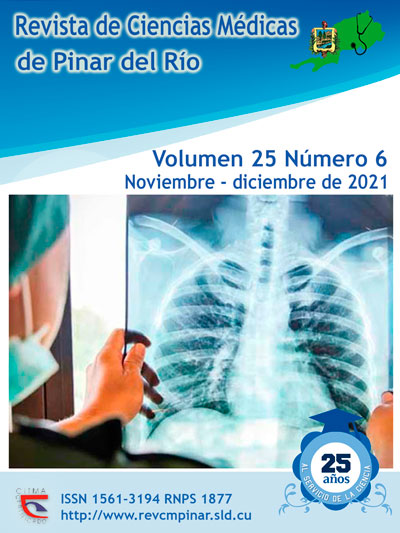Adverse reactions to diclofenac sodium reported in the Orthopedics service of the Joaquin Albarran Hospital
Keywords:
DICLOFENAC, DRUG-RELATED SIDE EFFECTS AND ADVERSE REACTIONS, PHARMACOVIGILANCE, ANTI-INFLAMMATORY AGENTS, NON-STEROIDAL.Abstract
Introduction: diclofenac sodium is a non-steroidal anti-inflammatory drug that has beneficial therapeutic properties to the relieve of pain and inflammation in diseases of the osteomyoarticular system; however, in recent years it has been the target of criticism due to cardiovascular safety alerts that place it in the risk-benefit balance.
Objective: to characterize adverse reactions to diclofenac sodium reported in the Orthopedics Service at Joaquin Albarran Hospital, in the period from 2018 to 2020.
Methods: observational, descriptive, cross-sectional, pharmacovigilance (PhV) study developed at Joaquin Albarran Hospital, during the period from 2018 to 2020 using the proactive method of detection of adverse reactions. The target group comprised 21 patients treated with diclofenac sodium who presented adverse reactions to this drug, working with them all. Descriptive statistics was applied.
Results: the predominant age group was 26 to 59 years old (57,1 %) and female sex (57,1 %), with headache (42,8 %) and hypertension (38,1 %) as the main adverse reactions reported. In terms of severity, moderate adverse reactions predominated (52,4%); all the notifications were classified as probable and according to frequency as occasional.
Conclusions: it is concluded that during the period of time in which the study was carried out, moderate adverse reactions were identified between 26 and 59 years old, mostly cardiovascular and with the same prevalence in female sex. Headache was the most common symptom according to the results obtained.
Downloads
References
1. Schiff GD, Galanter WL, Duhig J, Lodolce A, Koronkowski MJ, Lambert BL. Principles of Conservative Prescribing. Ach Intern Med. [Internet]. 2011 [citado 27/02/2021]; 171(16): 1433-1440. Disponible en: https://jamanetwork.com/journals/jamainternalmedicine/fullarticle/1105913
2. Machado Alba JE, Giraldo Giraldo C, Moncada Escobar J. Farmacovigilancia activa en pacientes afiliados al sistema general de seguridad social en salud. Rev. salud pública. [Internet]. 2010 [citado 27/02/2021]; 12(4): 23-25. Disponible en: https://www.scielosp.org/pdf/rsap/2010.v12n4/580-588/es
3. Alfonso Horta I, Jiménez G. Azitromicina y efectos cardiovasculares notificados al Sistema Cubano de Farmacovigilancia, 2003-2012. Rev Cubana Farm. [Internet]. 2014 [citado 27/02/2021]; 48(3): 1-5. Disponible en: http://scielo.sld.cu/scielo.php?script=sci_arttext&pid=S0034-75152014000300017
4. Jiménez G, Alfonso I. Normas y procedimientos de trabajo del sistema cubano de Farmacovigilancia. Ministerio de Salud Pública [Internet] 2011 [citado 27/02/2021]. Disponible en: https://files.sld.cu/cdfc/files/2012/10/normas-y-procedimientos-2012.pdf
5. Agencia Española de Medicamentos y Productos Sanitarios AEMPS. Barcelona, España. [Internet] 2021 [citado 27/02/2021]. Disponible en: https://www.aemps.gob.es/
6. Comité Europeo para la Evaluación de Riesgos en Farmacovigilancia (PRAC). Madrid España. [Internet] 2021 [citado 27/02/2021]. Disponible en: https://www.vacunacovid.gob.es/etiquetas/comite-europeo-para-la-evaluacion-de-riesgos-en-farmacovigilancia-prac
7. Nota informativa MUH (FV). Diclofenaco y riesgo cardiovascular: restricciones de uso. AEMPS. España. [Internet] 2013 [citado 27/02/2021]. Disponible en:
8. Schmidt M, Toft Sørensen H, Pedersen L. consume de diclofenac y riesgo cardiovascular: serie de estudios de cohorts nacionales. BMJ [Internet]. 2018 [citado 27/02/2021]; 362: k3426. Disponible en: https://www.fundacionfemeba.org.ar/blog/farmacologia-7/post/consumo-de-diclofenac-y-riesgo-cardiovascular-serie-de-estudios-de-cohortes-nacionales-46006
9. Jiménez López G, Gálvez González AM, García Fariñas A. Costo del tratamiento farmacológico de las reacciones adversas graves por medicamentos en Cuba (2003-2013). Rev Cubana Salud Pública. [Internet]. 2018 [citado 27/02/2021]; 44(4): 112-124. Disponible en: http://www.revsaludpublica.sld.cu/index.php/spu/article/view/1213
10. Martínez Torres MC, Barrios Almenares Y, Pérez Cruz N, Díaz Mato I. Consumo de analgésicos no opioides en servicios hospitalarios no ambulatorios. Revista Cubana de Farmacia [Internet]. 2021 [citado 27/02/2021]; 54(1): e499. Disponible en: http://www.revfarmacia.sld.cu/index.php/far/article/view/499
11. Loya Pérez L. Notificación de sospechas de reacciones adversas medicamentosas por enfermería. [Tesis] España: Universidad de Valladolid; 2019. Disponible en: https://uvadoc.uva.es/bitstream/handle/10324/36852/TFG-H1596.pdf?sequence=1
12. Vallejos Narváez Á, Calvache JC, Ávila MP, Iván Latorre S, Andrés Ruano C, Delgadillo J, et al. Prescripción de analgésicos y reacciones adversas en pacientes hospitalizados. Rev. colomb. cienc. quím. farm. [Internet].2018 [citado 27/02/2021]; 47(1): 86-104. Disponible en: http://www.scielo.org.co/scielo.php?script=sci_arttext&pid=S0034-74182018000100086
13. Díaz Matos I, Pérez Cruz N, Martínez Torres MC, Alfonso Hidalgo A. Prescripción de analgésicos no opioides en un Servicio de Ortopedia. Rev haban cienc méd [Internet]. 2021 [citado 27/02/2021]; 20(1): e_3158. Disponible en: http://www.revhabanera.sld.cu/index.php/rhab/article/view/3158
14. Agencia Nacional de Regulación Control y Vigilancia Sanitaria. Estadísticas del Centro Nacional de Farmacovigilancia, año 2018 (CNFV). Ecuador: Dirección Técnica de Vigilancia y Control. [Internet] 2019 [citado 27/02/2021]. Disponible en: https://www.controlsanitario.gob.ec/wp-content/uploads/downloads/2019/08/ESTAD%C3%8DSTICAS-DEL-CENTRO-NACIONAL-DE-F%C3%81RMACOVIGILANCIA-CNFV-1-SEMESTRE-2019-BOLETIN2.pdf
15. INFAC. Seguridad de medicamentos: señales y alertas generadas en 2013-2014. Antiinflamatorios no esteroideos. Diclofenaco riesgo cardiovascular. [Internet]. 2015 [citado 27/02/2021]; 23(3): 12. Disponible en: https://www.euskadi.eus/contenidos/informacion/cevime_infac_2015/es_def/adjuntos/INFAC_Vol_23_n_3_senales_alertas_2013_2014.pdf
16. Towards better patient care: drugs to avoid in 2020. PRESCRIRE [Internet]. 2020 [citado 27/02/2021]; 29(212): [aprox. 10p.]. Disponible en: https://english.prescrire.org/en/81/168/58376/0/NewsDetails.aspx?page=1
17. Del Nogal Sáez F, Blasco Navalpotro MA, Jiménez Jiménez J, Seoane Leston FJ. Reacción adversa grave a diclofenaco. Med. Intensiva [Internet]. 2011 [citado 27/02/2021]. 35(3); 194-195. Disponible en: https://www.medintensiva.org/es-reaccion-adversa-grave-diclofenaco-articulo-S0210569110002482
18. Tarragó Portelles SS, Gravier Hernández R, Gil del Valle L. La Farmacovigilancia en Cuba y la Infranotificaciones de Reacciones Adversas a los Medicamentos. Horizonte sanitario [Internet]. 2019 [citado 27/02/2021]; 18(1): 007-015. Disponible en: https://doi.org/10.19136/hs.a18n1.2514
Downloads
Published
How to Cite
Issue
Section
License
Authors who have publications with this journal agree to the following terms: Authors will retain their copyrights and grant the journal the right of first publication of their work, which will be publication of their work, which will be simultaneously subject to the Creative Commons Attribution License (CC-BY-NC 4.0) that allows third parties to share the work as long as its author and first publication in this journal are indicated.
Authors may adopt other non-exclusive license agreements for distribution of the published version of the work (e.g.: deposit it in an institutional telematic archive or publish it in a volume). Likewise, and according to the recommendations of the Medical Sciences Editorial (ECIMED), authors must declare in each article their contribution according to the CRediT taxonomy (contributor roles). This taxonomy includes 14 roles, which can be used to represent the tasks typically performed by contributors in scientific academic production. It should be consulted in monograph) whenever initial publication in this journal is indicated. Authors are allowed and encouraged to disseminate their work through the Internet (e.g., in institutional telematic archives or on their web page) before and during the submission process, which may produce interesting exchanges and increase citations of the published work. (See The effect of open access). https://casrai.org/credit/



